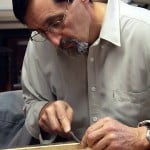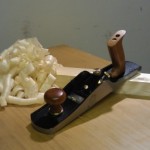Hand Planing
Welcome! / Forums / General Woodworking Discussions / Hand Planing
- This topic has 42 replies, 9 voices, and was last updated 11 years, 8 months ago by
Anonymous.
-
AuthorPosts
-
Anonymous5 November 2012 at 6:18 pm #2866
Hi Paul,
For some reason I have started to plane a taper into the far end of my boards. I take the pressure off the front of the plane as I get near the end of the board, but I’m still planing a taper, this is both on the face and the edge, I just don’t seem to be able to correct it.Ok buddy many thanks.
Ken
 5 November 2012 at 10:22 pm #2872
5 November 2012 at 10:22 pm #2872Hi Ken,
There are many influences on the plane that cause this. First off is the sharpness of the plane. If the edge is not truly sharp, the blade incrementally rises as the stroke is made and concludes with less shaving at the outstroke than at the instroke. This can also work in reverse. Another great and very common fault is what i call ‘bulldogging’ the plane down onto the wood instead of simply pushing the plane forward and letting the plane itself pull itself to the wood. Because of the angle the blade is set at, the iron pulls the plane down, so our task is not so much to press but to push. You must also check the flatness of the sole, the amount of blade protrusion and so on.
Other than that, without seeing the plane and your planing technique it’s difficult to give practical help.Best regards,Paul
I’ve watched several people “snipe” the ends of their boards with handplanes. They claim they are taking the pressure (shouldn’t need much in the first place) off the knob and transferring to the tote. But typically, they are leaning in (forward) so much that they can do nothing except press down with their off-hand and run the plane down over the exit edge. YMMV
I tell them to try this (really only works with a lightly set blade) as a way of teaching the muscle memory/body mechanics you need: simply let go of the knob all together as you exit the board. Just about all you can do is push forward on the tote without your off-hand holding the knob. But do hang on to the tote so you don’t end up throwing the plane on the floor! A couple of time through like that so that they get their body mechanics right and the plane takes a continuous shaving, they can put their off-hand back on the plane and maintain that light touch.
Dominant hand pushes the tote, off-hand steers the knob. This same sort of two hands & two independent jobs skill (pat your head and rub your belly at the same time) is necessary to make a plow plane, rabbet plane, moulding plane, etc work right so might as well train your brain with the bench planes too.
Anonymous6 November 2012 at 1:02 am #2891Paul / Rob, thanks guys. Yeah to much pressure was the problem. I planed up some scrap wood tonight till I got it right.
Many thanks
Ken
I am planning on building a bench similar to the one Paul recommends however I have a few questions. The first is how one would go about edge planing long boards. With the face vise not butting against the front of the bench how do you support the far end of the board. Secondly does the tool tray impede the use of holdfasts? If anyone uses a Paul style bench and has these answers I would be glad to hear them.
Thanks,
Josh 12 November 2012 at 7:45 am #3129
12 November 2012 at 7:45 am #3129This is a great question. A good vise will indeed support long boards within the jaws of the vise and the edge sitting in a planable position above the jaws. If the board is too wide and makes the board too high for comfortable or accurate planing, clamp the end in the vise and then clamp the board to the benchtop at the opposite end with a sash clamp. This is very simple to do. The only additional thing you will need is a packer the thickness of the vise jaw and liner, so that the board is parallel to the jaw. Alternatively you can add holes to the other leg face and put support dowels there. I often clamp a post to the board if the stock is too heavy for the vise alone. For boards and sticks, I use an alternative method using clamps in the vise. You can see the link here.
 12 November 2012 at 7:49 am #3130
12 November 2012 at 7:49 am #3130As to the second question. The well makes no difference to bench holdfasts as holdfasts can be used on both side benchtops. Also, we add a centre laminated block that fits in the well between the two main worktop areas and directly opposite the vise. This then allows for cross-bench dogging. We will cover this in later videos on the free YouTube bench making series we have been progressing lately.
Paul,
Thank you. I have had to do something similar with the makeshift bench I am using now. Have you ever permanently attached a filler piece to the far end of the bench to accomplish this? Or alternatively have you ever incorporated a sliding deadman in a bench design? I look forward to seeing the remaining youtube videos.
Sincerely,
Josh Frey
Maybe I’m missing something obvious, but are there any special benefits gained by having the vise jaw+liner protrude past the edge of the workbench top?
The thing I can imagine is that the installation will be more time consuming if one wants to have the vise recessed into the benchtop. 12 November 2012 at 2:35 pm #3135
12 November 2012 at 2:35 pm #3135I’ve made Paul’s bench and have been wondering about this edge planing problem for a while. I’m yet to need to plane the edges of a wide board but when the time comes I’m thinking I’ll put a filler block between the board and the apron on the opposite end to the vise. Putting some dogs holes and dogs into the bench leg would support it, too.
Recessing the vise and making it flush with the apron would solve the edge planing problem but you’d then be risking hitting the vise with your tools, which would damage them pretty badly. Installing it as per Paul’s design is really easy – just cut a hole in the apron and screw it in place.
George.
 12 November 2012 at 5:52 pm #3138
12 November 2012 at 5:52 pm #3138There is a good reason not to have the jaw flush and it’s simple. Most wood loading into the vise is mall stock such as drawer parts, rails, table legs and such. This means holding it with the less dominant hand as you tighten the vise with your right or vise versa, pun intended. With the gap the vise jaw and liner allows, there is room for the hand to grip the wood and tighten the vise without awkwardness or pinching your twixt wood and bench.
 12 November 2012 at 5:52 pm #3139
12 November 2012 at 5:52 pm #3139There is a good reason not to have the jaw flush and it’s simple. Most wood loading into the vise is mall stock such as drawer parts, rails, table legs and such. This means holding it with the less dominant hand as you tighten the vise with your right or vise versa, pun intended. With the gap the vise jaw and liner allows, there is room for the hand to grip the wood and tighten the vise without awkwardness or pinching your twixt wood and bench.
Anonymous12 November 2012 at 6:04 pm #3140One way of bypassing the potential for accidentally striking vise jaws with tools is to protect the tops of the jaws by extending the liners above the jaw height. This simply involves lowering the vise position by the intended thickness of added protection and protection can encompass the top and each end of the jaws by letting the vise into a reveal in the liner/liners.
I have been having an issue recently when edge planning boards. I seem to leaving the ends high and planning a hollow on the boards. This is a relatively easy fix when I go back and check with a straight edge, however it is odd to me as I was told when I first started that you should try to plane a hollow in order to avoid leaving the middle to high. Any suggestions on how to avoid this?
Anonymous17 November 2012 at 2:44 pm #3371Hi Josh,
How long is the edge and what size plane are you using? Planing hollow typically accompanies the use of a shorter plane on longer planing runs, but is easily remedied by frequently checking the edge whilst you work.
-
AuthorPosts
- You must be logged in to reply to this topic.
